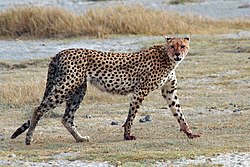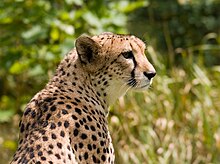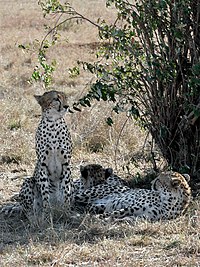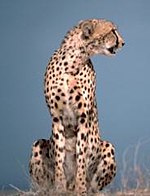Cheetah
- This article is about the animal. For other uses, see Cheetah (disambiguation).
| Cheetah[1] | |
|---|---|

| |
| Scientific classification | |
| Kingdom: | |
| Phylum: | |
| Class: | |
| Order: | |
| Family: | |
| Subfamily: | |
| Genus: | Acinonyx Brookes, 1828
|
| Species: | A. jubatus
|
| Binomial name | |
| Acinonyx jubatus (Schreber, 1775)
| |
| Type species | |
| Acinonyx venator | |

| |
| The range of the cheetah | |
The cheetah (derived from Sanskrit word Chitraka meaning "Speckled") (Acinonyx jubatus) is an atypical member of the cat family (Felidae), a poor climber that hunts by speed rather than by stealth. As such, it is placed in its own genus, Acinonyx. It is the fastest of all land animals and although its fastest speed is unknown, it can reach speeds of more than 105 km/h (65 mph)[3] in short bursts up to 460 metres (500 yards), as well as being able to accelerate from 0 to 110 km/h (≈70 mph) in three seconds, faster than most supercars.
Description

The cheetah has a slender, long-legged body with blunt non-retractable claws. Its chest is deep and its waist is narrow. Its coat is tan with small, round, black spots, and the fur is coarse and short. The cheetah has a small head with high-set eyes. Black "tear marks" run from the corner of its eyes down the sides of the nose to its mouth to keep sunlight out of its eyes and to aid in hunting and seeing long distances.
The adult animal weighs from 40 to 65 kg (90 to 140 lb). Its total body length is from 112 to 135 cm (45 in to 55 in), while the tail can measure up to 84 cm (33 in). Males tend to be slightly larger than females and have slightly bigger heads, but there is great variation in cheetah sizes and it is difficult to tell males and females apart by appearance alone.
The fur of the cheetah is tan with round black spots in order to help camouflage it. The cheetah's black spots measure from 2-3 cm (¾ to 1¼ inches) across. There are no spots on its white belly, however, the tail has spots, which merge to form four to six dark rings at the end. The cheetah's tail usually ends in a bushy white tuft.
Some cheetahs also have a rare fur pattern mutation: cheetahs with larger, blotchy, merged spots are known as 'king cheetahs'. It was once thought to be a separate subspecies, but it is merely a mutation of the African cheetah. The 'king cheetah' has only been seen in the wild a handful of times, but it has been bred in captivity.
The cheetah's paws have unretractable claws (known only in two other cat species - the Fishing Cat and the Iriomote Cat) offering the cat extra grip in its high-speed pursuits. The ligament structure of the cheetah's claws is the same as those of other cats; it simply lacks the sheath of skin and fur present in other varieties, and therefore the claws are always visible. With the exception of the dewclaw, the claw itself is also much shorter and straighter than other cats.
Adaptations that enable the cheetah to run as fast as it does include large nostrils that allow for optimal oxygen intake, and an enlarged heart and lungs that work together to circulate oxygen efficiently. While running, in addition to having good traction due to its semi-retractable claws, the cheetah uses its tail as a rudder-like means of steering to allow it to make sharp turns, necessary to outflank prey who often make such turns to escape.
Unlike "true" big cats, the cheetah can purr as it inhales, but cannot roar. By contrast, the big cats can roar but cannot purr, except while exhaling. However, the cheetah is still considered by some to be the smallest of the big cats. While it is often mistaken for the Leopard, the cheetah does have distinguishing features, such as the aforementioned long "tear-streak" lines on each side of its nose that run from the corner of its eyes to its mouth. The body frame of the cheetah is also very different from that of the Leopard, most notably so in its thinner and extra long tail.
The cheetah is a vulnerable species. Out of all the big cats, it is the least able to adapt to new environments. It has always proved difficult to breed in captivity, although recently a few zoos have been successful. Once widely shot for its fur, the cheetah now suffers more from the loss of both habitat and prey.
The cheetah is considered the most primitive of all cats, and until recently was thought to have evolved approximately 18 million years ago, although new research puts the last common ancestor of all 40 existing species of feline more recently, at 11 million years. The cheetah's natural enemies are the lion, hyenas, and the leopard.
Reproduction and social life

Females reach sexual maturity in twenty to twenty-four months, and males around twelve months (although they do not usually mate until at least three years old), and mating occurs throughout the year. Females give birth to up to nine cubs after a gestation period of ninety to ninety-eight days, although the average litter size is three to five. Cubs weigh from 150 to 300 g (5 to 10 oz.) at birth. Unlike some other cats, the cheetah is born with its characteristic spots. Cubs are also born with a downy underlying fur on their necks, called a mantle, extending to mid-back. This gives them a mane or Mohawk-type appearance; this fur is shed as the cheetah grows older. It has been speculated that this mane gives a cheetah cub the appearance of the Ratel, to scare away potential aggressors.
Death rate is very high during the early weeks, and up to 90% of the cubs are killed during this time by lions, hyenas or even by eagles. Cubs leave their mother between thirteen and twenty months after birth. The cheetah can live over twenty years, but its life is often short, for it loses its speed with old age.
Unlike males, females are solitary and tend to avoid each other, though some mother/daughter pairs have been known to continue for small periods of time. The cheetah has a unique, well-structured social order. Females live alone except when they are raising cubs and they raise their cubs on their own. The first eighteen months of a cub's life are important - cubs learn many lessons because survival depends on knowing how to hunt wild prey species and avoid other predators. At eighteen months, the mother leaves the cubs, who then form a sibling, or 'sib', group, that will stay together for another six months. At about two years, the female siblings leave the group, and the young males remain together for life. Life span is up to twelve years in wild, but up to twenty years in captivity.
Territories
Males
Males are very sociable and will group together for life, usually with their brothers in the same litter; although if a cub is the only male in the litter then two or three lone males may group up, or a lone male may join an existing group. These groups are called coalitions. A coalition is six times more likely to obtain a territory than a lone male, although studies have shown that coalitions keep their territories just as long as lone males - four to four and a half years.
Males are very territorial. Females' home ranges can be very large and trying to build a territory around several females' ranges is impossible to defend. Instead, males choose the points at which several of the females' home ranges overlap, creating a much smaller space, which can be properly defended against intruders while maximizing the chance of reproduction. Coalitions will try their utmost to maintain territories in order to find females with which they will mate. The size of the territory also depends on the available resources; depending on the part of Africa, the size of a male's territory can vary greatly from 37 km² to 160 km².
Males mark their territory by urinating on objects that stand out, such as trees, logs, or termite mounds. The whole coalition contributes to the scent. Males will attempt to kill any intruders and fights often result in serious injury or death.
Females
Unlike males and other felines, females do not establish territories. Instead, the area they live in is termed a home range. These overlap with other females' home ranges; often it will be the sisters from the same litter or a daughter's home range overlapping with her mother's. Females, however, always hunt alone, although once their cubs reach the age of five to six weeks they take them along to show them how it is done. The size of a home range depends entirely on the availability of prey. Cheetahs in African woodlands have ranges as small as 34 km², while in some parts of Namibia they can reach 1,500 km². Although there have been no studies, it is expected that the home ranges of females in the Sahara are the largest of all the cheetah populations.
Vocalizations
The cheetah cannot roar, unlike other big cats, but does have the following vocalizations:
- Yipping - When cheetahs attempt to find each another, or a mother tries to locate her cubs, it uses a high-pitched barking called yipping. The yips made by a cheetah cub sound more like a bird chirping, and so are termed chirping.
- Churring, stuttering or stutter-barking - This vocalization is emitted by a cheetah during social meetings. A churr can be seen as a social invitation to other cheetahs, an expression of interest, uncertainty, or appeasement or during meetings with the opposite sex (although each sex churrs for different reasons).
- Growling - This vocalization is often accompanied by hissing and spitting and is exhibited by the cheetah during annoyance, or when faced with danger.
- Yowling - This is an escalated version of growling, usually displayed when danger worsens.
- Purring - This is made when the cheetah is content, usually during pleasant social meetings (mostly between cubs and their mothers)
Diet and hunting

The cheetah is a carnivore, eating mostly mammals under 40 kg (90 lb), including Thomson's Gazelle and the Impala. Wildebeests and calves are hunted when the cheetah hunts in groups. Guineafowl and hares are also hunted. While the other big cats mainly hunt by night, the cheetah is a diurnal hunter. It hunts usually either early in the morning or later in the evening when it is not so hot, but there is still enough light - the cheetah hunts by vision rather than by scent. Prey is stalked to within 10-30 metres (30-100 feet), then chased. The chase is usually over in less than a minute, and if the cheetah fails to make a quick catch, it will often give up rather than waste energy.
Another reason the cheetah may give up is because running at such high speeds puts a great deal of strain on the cheetah's body. When sprinting, the cheetah's body temperature becomes so high that it would be deadly to continue - this is why the cheetah is often seen resting even after it has caught its prey. If it is a hard chase, it sometimes needs to rest for half an hour or more. Roughly half of the chases are successful. The cheetah kills its prey by tripping it during the chase, then biting it on the underside of the throat to suffocate it, for the cheetah is not strong enough to break the necks of the gazelles it mainly hunts. The bite may also puncture a vital artery in the neck. Then the cheetah proceeds to devour its catch as quickly as possible before the kill is taken by stronger predators.
Habitat

The cheetah thrives in areas with vast expanses of land where prey is abundant. In Namibia, it has been found in a variety of habitats, including grasslands, savannahs, dense vegetation, and mountainous terrain. Ninety-five percent live on commercial farms. The cheetah is found in the wild primarily in Africa, but in the past its range extended into India. Conservationists using camera traps have recently discovered surviving populations in Iran and are taking steps to protect them. In much of its former range, it was tamed by aristocrats and used to hunt antelopes in much the same way as is still done with members of the greyhound group of dogs. Aside from an estimated two hundred cheetahs living in Iran (Khorasan Province), the distribution of the cheetah is now limited to Africa. There are five subspecies of cheetah in the genus Acinonyx: four in Africa and one in Iran. The endangered subspecies Acinonyx jubatus venaticus lives in Asia (Iran). In 1990, there were reports in the Times of India of a cheetah sighting in eastern India. There is a chance some cheetahs remain in India, though it is doubtful. There have also been reports of Asiatic cheetahs in the Balochistan Province of Pakistan, though these continue to be unverified. The cheetah prefers to live in an open biotope, such as semi-desert, prairie, and thick brush.
Genetics and classification
The genus name, Acinonyx, means "no-move-claw" in Greek, while the species name, jubatus, means "maned" in Latin, a reference to the mane found in cheetah cubs.
The cheetah has unusually low genetic variability and high abnormal sperm count. Skin grafts between non-related cheetahs illustrate this point in that there is no rejection of the donor skin. It is thought that it went through a prolonged period of inbreeding following a genetic bottleneck during the last ice age. It probably evolved in Africa during the Miocene epoch (26 million to 7.5 million years ago), before migrating to Asia. New research by a team led by Warren Johnson and Stephen O’Brien of the Laboratory of Genomic Diversity (National Cancer Institute in Frederick, Maryland, United States) has recently placed the last common ancestor of all existing cat species as living in Asia. 11 million years ago, which may lead to revision and refinement of existing ideas about cheetah evolution. Now-extinct species include: Acinonyx pardinensis (Pliocene epoch), much larger than the modern cheetah and found in Europe, India, and China; Acinonyx intermedius (mid-Pleistocene period), found over the same range. The extinct genus Miracinonyx was extremely cheetah-like, but recent DNA analysis has shown that Miracinonyx inexpectatus, Miracinonyx studeri, and Miracinonyx trumani (early to late Pleistocene epoch), found in North America and called the "North American cheetah" are not true cheetahs, instead being close relatives to the Cougar.
Subspecies
For a short time it was thought that there were six subspecies of cheetah, but Acinonyx rex - the king cheetah (see below) - was abandoned after it was discovered the variation was only a recessive gene. The subspecies Acinonyx jubatus guttatus - the woolly cheetah - may also have been a variation due to a recessive gene. The current five sub-species of Acinonyx jubatus are:
- Acinonyx jubatus hecki - West Africa.
- Acinonyx jubatus jubatus - Southern Africa.
- Acinonyx jubatus raineyii - East Africa.
- Acinonyx jubatus soemmeringii - Central Asia.
- Acinonyx jubatus venaticus - Iran.
Morphs and variations
King cheetah
The king cheetah is a rare mutation of cheetah characterized by a distinct pelt pattern. It was first noted in Zimbabwe in 1926. In 1927, the naturalist Reginald Innes Pocock declared it a separate species, but reversed this decision in 1939 due to lack of evidence. In 1928, a skin purchased by Lord Rothschild was found to be intermediate in pattern between the king cheetah and spotted cheetah and Abel Chapman considered it to be a color form of the spotted cheetah. Twenty-two such skins were found between 1926 and 1974. Since 1927, the king cheetahs was reported five more times in the wild. Although strangely marked skins had come from Africa, a live king cheetah was not photographed until 1974 in South Africa's Kruger National Park. Cryptozoologists Paul and Lena Bottriell photographed one during an expedition in 1975. They also managed to obtain stuffed specimens. It appeared larger than a spotted cheetah and its fur had a different texture. There was another wild sighting in 1986 — the first in seven years. By 1987, thirty-eight specimens had been recorded, many from pelts.
Its species status was resolved in 1981 when king cheetahs were born at the De Wildt Cheetah Centre in South Africa. In May 1981, two spotted sisters gave birth there and each litter contained one king cheetah. The sisters had both mated with a wild-caught male from the Transvaal area (where king cheetahs had been recorded). Further king cheetahs were later born at the Centre. This mutation has been reported in Zimbabwe, Botswana and in the northern part of South Africa's former Transvaal province.
Other color variations
Other rare color morphs included speckled cheetahs, melanistic cheetahs, albino cheetahs and grayish cheetahs. Most were reported in Indian cheetahs, particularly in captive specimens kept for hunting.
The Mughal Emperor of India, Jahangir, recorded having a white cheetah presented to him in 1608. In the memoirs of Tuzuk-i-Jahangiri, the Emperor says that in the third year of his reign: Raja Bir Singh Deo brought a white cheetah to show me. Although other sorts of creatures, both birds and beasts have white varieties .... I had never seen a white cheetah. Its spots, which are (usually) black, were of a blue colour, and the whiteness of the body also inclined to blue-ishness. This suggests a chinchilla mutation which restricts the amount of pigment on the hair shaft. Although the spots were formed of black pigment, the less dense pigmentation gives a hazy, grayish effect. As well as Jahangir's white cheetah at Agra, a report of "incipient albinism" has come from Beaufort West according to Guggisberg.
In a letter to "Nature in East Africa", HF Stoneham reported a melanistic cheetah (black with ghost markings) in the Trans-Nzoia District of Kenya in 1925. Vesey Fitzgerald saw a melanistic cheetah in Zambia in the company of a spotted cheetah. Red (erythristic) cheetahs have dark tawny spots on a golden background. Cream (isabelline) cheetahs have pale red spots on a pale background. Some desert region cheetahs are unusually pale; probably they are better-camouflaged and therefore better hunters and more likely to breed and pass on their paler coloration. Blue (Maltese or gray) cheetahs have variously been described as white cheetahs with gray-blue spots (chinchilla) or pale grey cheetahs with darker grey spots (Maltese mutation). A cheetah with hardly any spots was shot in Tanzania on 1921 (Pocock), it had only a few spots on the neck and back and these were unusually small.
Woolly cheetah
Woolly cheetahs were reported in the 19th century as a separate species of cheetah that had longer, denser fur. Several specimens were obtained. It may be that creatures were in fact the same species as the present-day cheetah, but with a genetic disposition to long fur. The woolly cheetah has, in any case, vanished.
In 1877, Philip Sclater of the Zoological Society of London wrote of a recent acquisition by the zoo: It presents generally the appearance of a cheetah, but is thicker in the body, and has shorter and stouter limbs, and a much thicker tail. When adult it will probably be considerably larger than the cheetah, and is larger even now than our three specimens of that animal. The fur is much more woolly and dense than in the cheetah, as is particularly noticeable on the ears, mane and tail.
Woolly cheetahs were observed to have thicker bodies and stouter limbs than normal cheetahs, although this may have been a misleading appearance given by the long hair. They had dense, woolly hair especially on the tail and neck where it formed a ruff or mane. The long fur made the normal spotted cheetah pattern indistinct and the animals appeared pale fawn with dark, round blotches.
Long hair in cats is due to recessive genes, so the pertinent gene here may still be present in a few individuals. However, the cheetah gene pool is unusually uniform so the lack of modern longhaired cheetahs means the mutation has probably vanished.
The whole of the body is of a pale isabelline color, rather paler on the belly and lower parts, but covered all over, including the belly, with round dark fulvous blotches. There are no traces of the black spots which are so conspicuous in all of the varieties of the cheetah which I have seen, nor of the characteristic black line between the mouth and eye.
Although described as blotched, a painting of the cheetah depicts it as freckled and the artist mistakenly added "eyeliner" markings which were not present in the actual specimen. In 1878, a second woolly cheetah was reported as a preserved specimen in the South African Museum. Both the London and South African specimens had come from Beaufort West. In 1884, a third skin was obtained from the same area, though this had more distinct spots and was a little smaller. By the 1880s, the trophy hunters had eliminated the woolly cheetah.
In Harmsworth Natural History (1910), R Lydekker wrote of the "hunting leopard" or "chita" (old spelling of cheetah) in which he distinguished it from the "normal" cheetah: "The hunting leopard of South Africa has been stated to differ from the Indian animal in its stouter build, thicker tail, and denser and more woolly fur, the longest hairs occurring on the neck, ears, and tail. This woolly hunting leopard was regarded by its describer as a distinct species (Cynaelurus lanius), but it is, at most, only a local race, of which the proper name is C. jubatus guttatus."
Economic importance
Cheetah fur was formerly regarded as a status symbol. Today, cheetahs have a growing economic importance for ecotourism and they are also found in zoos. Because cheetahs are far less aggressive than other big cats, cubs are sometimes sold as pets.
Cheetahs were formerly, and are sometimes still, hunted because many farmers believe that they eat livestock. When the species came under threat, numerous campaigns were launched to try to educate farmers and encourage them to conserve cheetahs. Recent evidence has shown that cheetahs will not attack and eat livestock, if they can avoid doing so, as they prefer their wild prey. However, they have no problem with including farmland as part of their territory, leading to conflict.
Ancient Egyptians often kept them as pets, and also tamed and trained them for hunting. Cheetahs would be taken to hunting fields in low-sided carts or by horseback, hooded and blindfolded, and kept on leashes while dogs flushed out their prey. When the prey was near enough, the cheetahs would be released and their blindfolds removed. This tradition was passed on to the ancient Persians and carried to India. This practice continued into the twentieth century by Indian princes. Cheetahs continued to be associated with royalty and elegance, their use as pets spreading just as their hunting skills were. Other such princes and kings kept them as pets, including Gengis Khan and Charlemagne, who boasted of having kept cheetahs within their palace grounds. As recently as the 1930s the Emperor of Abyssinia, Haile Selassie, was often photographed leading a cheetah by a leash.
Conservation status
Cheetah cubs have a high mortality rate due to genetic factors and predation by carnivores in competition with the cheetah, such as the lion and hyena. Some biologists now believe that they are too inbred to flourish as a species.
Cheetahs are included on the IUCN list: vulnerable species (African subspecies threatened, Asiatic subspecies in critical situation) as well as on the US ESA: threatened species - Appendix I of CITES (Convention on International Trade in Endangered Species). Approximately 12,400 cheetahs remain in the wild in twenty-five African countries; Namibia has the most, with about 2,500. Another fifty to sixty critically endangered Asiatic cheetahs are thought to remain in Iran. There have been successful breeding programs, including the use of in-vitro fertilization, in zoos around the world.
Founded in Namibia in 1990, the Cheetah Conservation Fund's mission is to be an internationally recognised centre of excellence in research and education on cheetahs and their eco-systems, working with all stakeholders to achieve best practice in the conservation and management of the world's cheetahs.
The Cheetah Conservation Foundation was set up in 1993 for the cheetah protection. It is based in South Africa.
Cultural references to cheetahs

- In Titian's Bacchus and Ariadne (1523), the god's chariot is borne by cheetahs (which were used as hunting animals in Renaissance Italy). Cheetahs were often associated with the god Dionysus, whom the Romans called Bacchus.
- George Stubbs' Cheetah with Two Indian Attendants and a Stag (1764-1765) also shows the cheetah as a hunting animal and commemorates the gift of a cheetah to George III by the English Governor of Madras, Sir George Pigot
- The Caress (1896), by the Belgian symbolist painter Fernand Khnopff (1858-1921), is a representation of the myth of Oedipus and the Sphinx and portrays a creature with a woman's head and a cheetah's body (often misidentified as a leopard's).
- In the Sherlock Holmes short story The Adventure of the Speckled Band by A. Conan Doyle, a cheetah is mentioned as patrolling the grounds of Dr. Grimesby Roylott's home.
- André Mercier's Our Friend Yambo (1961) is a curious biography of a cheetah adopted by a French couple and brought to live in Paris. It is seen as a French answer to Born Free (1960), whose author, Joy Adamson, produced a cheetah biography of her own, The Spotted Sphinx (1969).
- Clare Bell's young adult novel Tomorrow's Sphinx (1986) is an unusual story from the point of view of a misfit cheetah living on an abandoned Earth far in the future.
- The animated series ThunderCats had a main character who was an anthropomorphic cheetah named Cheetara.
- In 1986 Frito-Lay introduced an anthropomorphic cheetah, Chester Cheetah, as their mascot for their Cheetos.
- Comic book superheroine Wonder Woman's chief adversary is Dr. Barbara Ann Minerva, alias The Cheetah
- In the 2004 movie Harold & Kumar Go to White Castle, the protagonists encounter a cheetah in the woods that is dining upon human remains. However, the cheetah turns out to be friendly toward the pair, and Kumar gets the idea to smoke marijuana with the cheetah. They then ride the cheetah for a distance before Harold collides with a low branch and gets knocked out.
- The 2005 movie Duma is about a young South African attempting to return his pet cheetah Duma to the wild, with many adventures along the way. It was based on the book "How It Was With Dooms: A True Story from Africa" by Carol Cawthra Hopcraft and Xan Hopcraft.
- A skit on the Australian show Ronnie Johns mentions "The cheetah 'moves at speeds up to 76 kph. If a human raced with a cheetah, the cheetah would beat you, then it would probably eat you. The cheetah is better than you'."
References
- ^ Wozencraft, W. C. (2005). "Order Carnivora". In Wilson, D. E.; Reeder, D. M. (eds.). Mammal Species of the World: A Taxonomic and Geographic Reference (3rd ed.). Johns Hopkins University Press. pp. 532–533. ISBN 978-0-8018-8221-0. OCLC 62265494.
- ^ Template:IUCN2006 Database entry includes justification for why this species is vulnerable.
- ^ The cheetah's fastest recorded speed was 105km/h (65.25 mph). Cheetah, Luke Hunter and Dave Hamman, (Struik Publishers, 2003), pp. 37-38
General references
- Great Cats, Majestic Creatures of the Wild, ed. John Seidensticker, illus. Frank Knight, (Rodale Press, 1991), ISBN 0-87857-965-6
- Cheetah, Katherine (or Kathrine) & Karl Ammann, Arco Pub, (1985), ISBN 0-668-06259-2.
- Cheetah (Big Cat Diary), Jonathan Scott, Angela Scott, (HarperCollins, 2005), ISBN 0-00-714920-4
- Science (vol 311, p 73)
- Cheetah, Luke Hunter and Dave Hamman, (Struik Publishers, 2003), ISBN 1-86872-719-X
- Allsen, Thomas T. (2006). "Natural History and Cultural History: The Circulation of Hunting Leopards in Eurasia, Seventh-Seventeenth Centuries." In: Contact and Exchange in the Ancient World. Ed. Victor H. Mair. University of Hawai'i Press. Pp. 116-135. ISBN-13: ISBN 978-0-8248-2884-4; ISBN-10: ISBN 0-8248-2884-4
External links
- Cheetah: Wildlife summary from the African Wildlife Foundation
- Cheetah Conservation Fund
- De Wildt Cheetah and Wildlife Trust
- Cheetah Factsheet
- Woolly Cheetah, Colour Variations of Cheetah
- General Information on cheetahs
- Cheetahs Prey on a Gnu
- King Cheetahs and Other Variations in Cryptozoology
- Measuring the speed of a cheetah
- Pictures of the cheetah
- Sound recordings of cheetah and other animals at Moscow Zoo
- IUCN Red List vulnerable species
- Felines
- Fauna of Algeria
- Fauna of Angola
- Fauna of Botswana
- Fauna of the Democratic Republic of the Congo
- Fauna of East Africa
- Fauna of Ethiopia
- Fauna of Iran
- Fauna of Kazakhstan
- Fauna of Namibia
- Fauna of Pakistan
- Fauna of the Sahara
- Fauna of South Africa
- Fauna of Sudan
- Fauna of West Africa
- Fauna of Zambia

